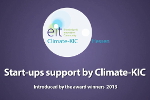Catalysing Green Infrastructures (Green Infra)
Challenge Platform: Land and water
Project Start Date: 08/2013
Lead partner: Deltares, NL
Project type: Pathfinder- Explores relevant climate arenas to identify and prioritise innovation opportunities
Project lead: Jos Brils, Deltares
Partners
The Green Infra project involves 5 partners:
Concept
The restoration of riparian areas and green space in flood prone urban spaces increases their capacity for water retention and flood prevention. As well as producing a more pleasant environment, green infrastructure also delivers long-term storage of emitted carbon, and is therefore a useful tool for climate change mitigation. The Green Infra project aims to develop a globally applicable framework for stakeholders that makes them rethink ‘from grey to green’ and thus catalyse the development of green infrastructure.
The Climate Change Issue
Flooding causes devastation to urban and rural areas if it is not managed properly. Green infrastructure aims to boost the restoration of flood prone areas and provide an alternative, or at least a valuable addition to orthodox, ‘grey’ methods of flood prevention such as the raising of dykes. Green infrastructure assists climate mitigation and results in a greener environment which is more attractive for living, recreation and tourism, boosting local economy. However, the social and environmental advantages of green infrastructure are often limited by a misbalanced cost distribution, land use regulations and unawareness about the potential benefits.
The Project Solution
Three types of green infrastructure solutions will be considered in this project. The aim is to promote their implementation among stakeholders by making them rethink ‘from grey to green’ infra solutions.
Foreshore and inland shore concepts: By planting trees at the foreshore, the energy of flood waves are reduced, subsequently reducing the risk of water passing over dykes. The inland shore is usually an area of low lying land connected to the source of water through inlets in the dyke and often connected to the regional water system. It is designed to store and release water when appropriate.
Dyke realignment: Dykes are moved further from the shore resulting in river widening, i.e. more ‘room for the river’. This generates a more (bio)diverse and green landscape which contributes to the value of the green infrastructure.
Urban storm water absorption and filtration: This aims to accelerate the absorption and filtration of storm water into the native soils of the urban environment. In cities where rain washes over surfaces quickly, pollutants are collected and carried by the flow to rivers and streams. If storm water is absorbed at its source the damage is lowered significantly as pollutants are naturally filtered out of the water before it reaches watercourses.
Green Infra aims to develop a framework that will catalyse the ‘from grey to green’ rethinking of stakeholders. It will make them aware of the benefits and thus consider using a range of ecosystem services and modular tools to better balance the distribution of the costs and benefits of green infrastructure to the stakeholders. This framework will be developed using experiences from five case studies, each site benefiting from the development of green infrastructure in flood prone areas.
The long-term aim of the project is to show the commercial potential of the framework and subsequently put it into practice. Inspiration will be drawn from other Climate-KIC projects developing ecosystem services to further promote the implementation of green infrastructure.
The Role of Climate-KIC
Climate-KIC provides a network of partners to the project. This network has assisted the project from its infancy right through to the stage it’s at now. The project has also benefited hugely from Climate-KIC’s funding.



